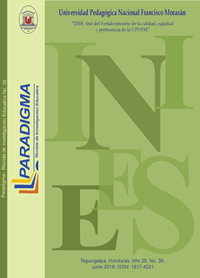Hábitos dietéticos, obesidad y vida universitaria para estudiantes de enfermería
Palabras clave:
hábitos alimentarios, estudiantes de enfermería, nutriciónResumen
El comportamiento de salud de los estudiantes de enfermería a menudo es inadecuado en términos de hábitos alimenticios, actividad física, tabaquismo y consumo de alcohol. El objetivo principal de este documento de posición es explorar los hábitos alimentarios, la obesidad y la vida universitaria en estudiantes de enfermería. Esta revisión crítica cubre tres dimensiones distintas de la vida estudiantil relacionadas con los estudios de enfermería, es decir, las conductas de alimentación y estilo de vida de los estudiantes de enfermería; el período de transición y el riesgo de ganar peso; el origen nacional de los estudiantes y las conductas alimentarias. La obesidad está aumentando no solo en el mundo occidental, sino también en los países en desarrollo. La vida universitaria es un período de transición donde aumenta el riesgo de aumento de peso. A menudo, el estrés puede llevar a los estudiantes a “atracones” de problemas de alimentación y peso. En términos de origen nacional y comportamiento alimentario de los estudiantes, las elecciones dietéticas para las estudiantes de enfermería son multifacéticas, como pueden ser sus antecedentes culturales. Las enfermeras, entre otros profesionales de la salud, encuentran barreras para estilos de vida positivos y una alimentación saludable, al igual que muchos de sus pacientes. Además, como los profesionales de la salud son considerados como posibles promotores de salud, su propio comportamiento de salud representa una importante función clínica y educativa. Sin embargo, el conocimiento nutricional no es fácil de aplicar ya que hay mucha desinformación disponible tanto en línea como en otros lugares. Dadas las condiciones altamente estresantes asociadas con su profesión, las enfermeras también deben cuidar su propia salud. Por lo tanto, existe la necesidad de diseñar programas educativos para los currículos de enfermería actuales para alentar estilos de vida saludables que incluyen lidiar con el estrés, el aumento de la actividad física, alimentos saludables y opciones de bebidas.
Citas
Azza, M., Soad, A., & Yousseria, E. (2014). Relationship between Stress and Eating Habits among Nursing Students. Assiut Med. J. Cairo Univ, 82(2), 47-55.
Balhara, Y., Mathur, S., & Kataria, D. (2012). Body Shape and Eating Attitudes among Female Nursing Students in India. East Asian Archives of Psychiatry, 22(2), 70-74.
Banwell, C., Lim, L., Seubsman, S.A., Bain, C., Dixon, J., & Sleigh, A. (2009). Body mass index and health-related behaviours in a national cohort of 87,134 Thai Open University students. J. Epidemiol Community Health, 63, 366–372.
Barzegari, A., Ebrahimi, M., Azizi, M., & Ranjbar, K. (2011). A study of Nutrition knowledge, attitudes and food habits of college students. World Applied Sciences Journal, 15(7), 1012-1017.
Beasley, L., Hackett, A., & Maxwell, S. (2004). The dietary and health behaviour of young people aged 18-25 years living independently or in the family home in Liverpool. International Journal of Consumer Studies, 28(4), 355-363.
Blas, E., Sommerfeld, J., & Sivasankara Kurup, A. (2011). Social determinants approaches to public health: from concept to practice. 1st ed. Geneva: World Health Organization.
Blichfeldt, B. S., & Gram, M. (2013). Lost in Transition? Student food consumption. Higher Education, 65(3), 277-289.
Bray, G. A. (2015). Why Obesity? Annual Review of Nutrition 35, 1-31.
Brown, L. (2009). The role of food in the adjustment journey of international students. In: H. M. Lindgreen A, ed. The New Cultures of Food: Marketing Opportunities from Ethnic, Religious and Cultural. Diversity. (pp. 37-56). London: Gower Publishing Limited.
Celik, S., Ugur, B., Aykurt, F., & Bektas, M. (2015). Eating Attitudes and Related Factors in Turkish Nursing Students. Nursing and Midwifery Studies, 4(2), 1-8.
Cutillas, A., Herrero, E., Eustaquio, A., Zamora, S., & Pérez-Llamas, F. (2013). Prevalence of underweight, overweight and obesity, energy intake and dietary caloric profile in university students from the region of Murcia (Spain). Nutr Hosp. 28(3), 683-689.
Deliens, T., Clarys, P., De Bourdeaudhuij, I., & Deforche, B., (2014). Determinants of eating behaviour in university students: a qualitative study using focus group discussions. BMC Public Health, 14(1), 53-54.
Denovan, A., & Macaskill, A. (2013). An interpretative phenomenological analysis of stress and. British Educational Research Journal, 39(6), 1002-1024.
Edwards, J.S., Hartwell, H.L., & Brown, L. (2010). Changes in food neophobia and dietary habits of international students. Journal of Human Nutrition and Dietetics, 23(3), 301-311.
Evagelou, E; Polikandrioti, M; Koutelekos, I., Dousis, E., & Kyritsi, E. (2014). Health Science Journal, 8(4), 452-468.
Gearhardt, A.G., Bragg, M.A., Pearl, R.L., Schvey, N.A., Roberto, C.A., & Brownell K.D. (2012). Obesity and Public Policy. Annual Review of Clinical Psychology 8, 405-430.
Georgiou, C.C., Betts, N.M., & Hoerr, S.L. (1997). Among Young Adults, College Students and Graduates Practiced more Healthful Habits and made more Healthful Food Choices than did Nonstudents. Journal of the American Dietetic Association, 97(7), 754-759.
Gordon-Larsen, P., Harris, K., Ward, D., & Popkin, B. (2003). Acculturation and overweight-related behaviors among Hispanic immigrants to the US: the National Longitudinal Study of Adolescent Health. Social Science & Medicine, 57, 2023-2034.
Huang, T.T., Harris, K.J., Lee, R.E., & Naziret, N. (2003). Assessing overweight, obesity, diet, and physical activity in college students. Journal of American College Health, 52(2), 83-86.
Irazusta, A., Gil S., Ruiz F., & Gil, J. (2006). Exercise, Physical Fitness, and Dietary Habits of First-Year Female Nursing Students. Biological Research for Nursing, 7(3), 175-186.
Ismawati, S., Zainalabidin, M., & Golnaz, R. (2014). Healthy Eating: The Preventive Factors among Malaysians. Journal of Economics, Business and Management, 2(4), 257-261.
Keyworth, C., Peters S., Chisholm, A., & Hart, J. (2013). Nursing students’ perceptions of obesity and behaviour change: implications for undergraduate nurse education. Nurse Educ Today, 33(5), 481-485.
Knutson, K. (2012). Does inadequate sleep play a role in vulnerability to obesity? American Journal of Human Biology, 24(3), 361-371. doi: 10.1002/ajhb.22219
Kok, C. M. (2013). Exploring Familial Themes in Malaysian Students’ Eating Behaviors. Journal of Human Sciences and Extension, 1(1), 125-142.
Kolleck, B. (2004). Smoking among nursing students. Pflege, 17(2), 98-104.
Lehmann, F., von Lindeman, K., Klewer, J., & Kugler, J. (2014). BMI, physical inactivity, cigarette and alcohol consumption in female nursing students: a 5-year comparison. BMC Medical Education, 14, 82-89.
Mintz, S.W., & Du Bois, C.M. (2002). The Anthropology of Food and Eating. Annual Review of Anthropology 31, 99-119.
Nelson, M.C; Larson, N.I., Barr-Anderson, D., Neumark-Sztainer, D., & Story, M. (2009). Disparities in Dietary Intake, Meal Patterning, and Home Food Environments Among Young Adult Nonstudents and 2- and 4-Year College Students. American Journal of Public Health, 99(7), 1216-1219.
Nojomi, M., & Najamabadi, S. (2006). Obesity among university students, Teheran, Iran. Asia Pac. J. Clin. Nutr. 15, 516–520.
Osaka, R., Nanakorn, S., Sanseeha, L., Nagahiro, C., & Kodama, N. (1999). Healthy dietary habits, body mass index, and predictors among nursing students, northeast Thailand. The Southeast Asian Journal of Tropical Medicine and Public Health, 30(1), 115-121.
Peltzer, K., Pengpid, S., Samuels, A., Özcan N., Mantilla, C., Rahamefy, O., Wong, M., & Gasparishvili, A. (2014). Prevalence of Overweight/Obesity and its Associated Factors among University Students from 22 Countries. Int J Environ Res Public Health. 11(7), 7425–7441.
Perez-Cueto, F., Verbeke, W., Lachat, C., & Remaut-De Winter, A.M. (2009). Changes in dietary habits following temporal migration. The case of international students in Belgium. Appetite, 52(1), 83-88.
Pullman, A.W; Masters, R.C., Zalot, L.C., Carde, L.E., Saraiva, M.M., Dam, Y.Y., Randall, Simpson J.A., & Duncan, A.M. (2009). Effect of the transition from high school to university on anthropometric and lifestyle variables in males. Applied Physiology, Nutrition and Metabolism, 34(2), 162-171.
Purcell, C., Moyle, W., & Evans, K. (2006). An exploration of modifiable health associated risk factors within a cohort of undergraduate nursing students. Contemp Nurse. 23(1), 100-110.
Raubenheimer, D., & Simpson, S. (2016). Nutritional Ecology and Human Health. Annual Review of Nutrition 36:603:626.
Reed, D. (2014). Healthy Eating for Healthy Nurses: Nutrition Basics to Promote Health for Nurses and Patients. The Online Journal of Issues in Nursing, 19(3), 14-20.
Seguin, R., Connor, L., Nelson, M., LaCroix, A., & Eldridge, G. (2014). Understanding Barriers and Facilitators to Healthy Eating and Active Living in Rural Communities. Journal of Nutrition and Metabolism, 14, 1-8. doi: 10.1155/2014/146502
Sepulveda, A., Carrobles, J.A., & Gandarillas, A.M. (2010). Associated Factors of Unhealthy Eating Patterns among Spanish University Students by Gender. The Spanish Journal of Psychology, 13(1), 364-375.
Sharma, B., Harker, M., Harker, D., & Reinhard, K. (2010). Youth transition to university in Germany and Australia: an empirical investigation of healthy eating behaviour. Journal of Youth Studies, 13(3), 353-367.
Tanton, J., Dodd, L.J., Woodfield, L., & Mabhala, M. (2015). Eating Behaviours of British University Students:A Cluster Analysis on a Neglected Issue. Advances in Preventive Medicine, 15, 1-8. doi:10.1155/2015/639239
Tavelli, S., Beerman, K., Shultz, J. & Heiss, C. (1998). Sources of error in nutritional adequacy of the food guide pyramid. Journal of American College Health, 47, 77–82.
Tirelli, C., Martínez-Ruiz, M.P., & Gómez-Ladrón-De-Guevara, R. (2013). Major influences on buying decision processes by international university students. Differences by continent of origin. Appetite, 71, 104-112.
Trujillo-Hernández, B., Vásquez, C., Almanza-Silva, J.R., JaramilloVirgen, M.E., Mellin-Landa, T.E., Valle-Figueroa, O.B., PérezAyala, R., Millán-Guerrero, R.O., Prieto-Díaz-Chávez, E., & Newton-Sánchez, O. (2010). The frequency of risk factors associated with obesity and being overweight in university students from Colima, Mexico. Rev. Salud Pública, 12, 197–207.
Van den Berg, V., Okeyo, A., Dannhauser, A., & Nel, M. (2012). Body weight, eating practices and nutritional knowledge amongst university nursing students, Eastern Cape, South Africa. African Journal of Primary Health Care & Family Medicine, 4(1), 323-331.
Vandelanotte, C., Duncan, M.J., Hanley, C., & Mummery, W.K. (2011). Identifying population subgroups at risk for underestimating weight health risks and overestimating physical activity health benefits. Journal of Health Psychology, 16(5), 760-769.
Vargas, M., Becerra, F., & Prieto, E. (2008). Anthropometric evaluation of university students in Bogotá, Colombia. Rev. Salud Pública, 10, 433–442.
Wengreen, H.J., & Moncur, C. (2009). Change in diet, physical activity, and body weight among young-adults during the transition from high school to college. Nutrition Journal, 8,32-37.
Descargas
Publicado
Versiones
- 25-06-2020 (1)
- 18-06-2018 ()
Cómo citar
Número
Sección
Licencia

Esta obra está bajo una licencia internacional Creative Commons Atribución-NoComercial-SinDerivadas 4.0.








